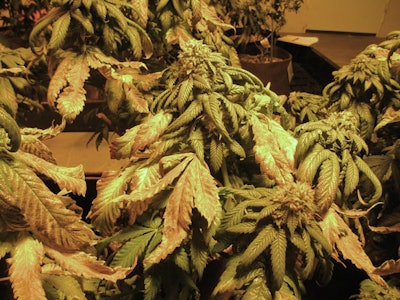
Fertilization problems are among the most common that we encounter when working to improve cultivation operations. Frequently, the root cause of the problem is a misunderstanding of plant physiology, which leads to growers simply following “feed charts,” without looking to fundamental, successful approaches from established agricultural models.
In this column, we will reframe common industry perceptions of nutrients and fertilization with an introduction to the “soil food web.” We also will explain natural fertilization approaches that are inexpensive, highly productive and provide multifaceted benefits, such as pest and disease resistance. And, we include recommendations for those employing hydroponic systems, in addition to general guidance on monitoring and testing your nutrient solution, media and runoff to ensure that you are doing what is best for your plants — which translates to high-yielding, high-quality harvests.
Please Don’t ‘Feed’ the Plants
As a first step, it’s necessary to understand that the common industry terminology around fertilization, that we are “feeding” plants, is incorrect. Plants are autotrophs, which are organisms able to form nutritional organic substances from simple inorganic substances. In other words, plants feed themselves. Specifically, plants are photoautotrophs, as they employ light, water (H2O) and carbon dioxide (CO2) to generate sugar (C6H12O6) and oxygen (O2), a process called photosynthesis. The photosynthetic equation itself (6CO2 + 6H2O + light = C6H12O6 + 6O2) includes only those inputs noted above; mineral nutrients are not directly present in the most essential process in plant physiology.
Nutrients are necessary to facilitate various metabolic processes, including photosynthesis in certain ways. The nutrients plants need in the greatest quantities are called macronutrients, and include nitrogen, phosphorus and potassium (the NPK you see listed on most fertilizers) as well as calcium, magnesium and sulfur. Iron, boron, manganese and others are classified as micronutrients, as plants need these elements, but in smaller amounts.
A Little Help From Their Friends
Plants are not on their own in taking up nutrients from the soil, however, and have evolved to form symbiotic relationships with innumerable bacteria, fungi and other microorganisms that assist them. These relationships have been dubbed the “soil food web.” In an amazing process too complex to explain fully here, plants transport some of the sugars they produce down to their roots and into the surrounding soil. Those sugars, called exudates, serve to attract and feed friendly microbiology, which in turn each play roles in helping to convert nutrients in the soil into their plant-available forms.
Due to the importance of soil food web relationships, we believe that bio-mimicry — working with a plant’s natural processes — is the best approach to fertilization. That means feeding the microbiological life in the soil, along with supplying natural precursors to the nutrients plants need. In other words, rather than “feeding” plants, it’s more like setting the table for them to handle things themselves, which they have been doing very well for millions of years.
We prefer this approach for a number of reasons.
First, natural fertilization is necessary to foster vibrant microbiological life in your soil. Most synthetic fertilizers are salts that can kill friendly bacteria and fungi by pulling water out of their cells via osmosis. While one might think that since synthetic fertilizers already provide nutrients in plant-available form, the soil food web is not necessary, but eliminating a plant’s microscopic support system has a detrimental effect on overall plant health. Some symbiotic relationships between plants and good microorganisms serve other ends, such as boosting the plant’s induced systemic resistance (ISR). ISR is a state of enhanced defensive capacity prompted by environmental stimuli (in this case, soil food web relationships), whereby the plant’s natural defenses are heightened against pests and pathogens.
Beneficial microbes also help keep plants healthy by simply occupying space and not allowing harmful organisms to establish themselves and attack the plant. Some good bacteria and fungi also release allelochemicals, which repel or harm pathogenic microorganisms. Friendly fungi, specifically those that establish endomycorrhizal relationships, also can provide drought resistance by forming haustoria, in which fungal hyphae actually penetrate root cells to facilitate their acquisition of nutrients from the plant. However, in cases of drought or insufficient irrigation, the endomycorrhizal fungi will actually desiccate itself almost completely in order to provide water to the host plant.

As you can see, there is more to the soil food web than simply nutritional benefits for the plant. The overall increase in plant health, promotion of ISR, and drought protection gained by fostering happy microbes in the soil with natural fertilization can feed your plants effectively, while also mitigating the ability of pests to take hold in your garden.
Second, natural fertilization options exist that are inexpensive and provide multifaceted benefits. In some cases, commercial cultivators can reduce costs by going straight to the source and purchasing appropriate forms of the raw materials included in commercial fertilizer lines. One example of this is Epsom salt, or magnesium sulfate, which can replace pricey magnesium supplements while providing sulfur, another important macronutrient.
Third, fertilizing naturally and promoting the soil food web in your medium also helps you get a better return on investment when it comes to nutrient use. This is because synthetic fertilizers easily leach through media. Your plants will take up some of nutrients provided, but much of it will run out the bottom of your containers unless a recirculating system is being employed. On the other hand, by feeding friendly microbes in your soil, nutrients are immobilized and retained within their cells, where they are eventually released as waste products.

Hydroponic Guidelines: Less Can Be More
While we recommend natural fertilization in soil, we understand that many (likely the majority of) cultivators employ hydroponic methods, which run the gamut from deep water culture to growing in inert media such as coconut coir or rockwool. For those operators, a simple principle can boost your bottom line: less can often be more. We always advise that growers start with ready-made feed charts, then run trials to see how much fertilization can be reduced while still maintaining desired yield and quality.
In many instances, we have seen yields increase as fertilization rates were lowered. This is not necessarily the fault of the feed chart or the company that made it; nutrient needs will vary according to strain and, more importantly, environmental conditions. A basic example would be a crop that is not receiving enough light. In this case, photosynthesis is not being performed at a high rate and less fertilization will be needed because a plant’s metabolic processes will have slowed.
Achieving higher yields by lowering fertilization rates should not be a surprise. Many “base” products in synthetic fertilizer lines contain nitrogen and are prescribed throughout the plant’s entire life. However, plants need different nutrient ratios at different life stages, and the overuse of nitrogen is detrimental to the flowering process. Too much nitrogen also can encourage excessive primary growth during the early flower “stretch,” making plants overly tall and unwieldy to manage. Over-fertilization generally can be detrimental to quality and lead to flowers that are harsh to smoke, as nutrients remain in the buds after harvest. Additionally, it can invite pest problems. Spider mites, for example, love to pierce the cells of leaves that are stuffed with excess nutrients. We have seen the frequency and intensity of pest incursions subside in facilities in which fertilization rates were systematically lowered.
Fertilization rates can be lowered by diluting nutrient solutions, introducing periodic flushing throughout the veg and flower processes, or both. However, if you have read our previous columns, you know that you will want to focus on a single variable at a time.
Also remember that fertilization is not limited to fertigation (watering plants with nutrient solution). You can fertilize by amending soil or other media with slow- or fast-release materials, as well as foliar feeding (applying liquid fertilizer directly to leaves) in veg or early flower, prior to buds emerging. Foliar feeding is a great way to selectively provide an element that might be lacking, or to bypass unfavorable conditions in your media preventing the proper uptake of nutrients, such as extreme pH levels or high saline conditions.
The Importance of Data Collection
Dialing in the optimal fertilization rates and approaches to promote maximum production is a gradual process that will require daily data collection, observations, and retrospective analysis of yield, potency test results, qualitative product inspection (look and smell), customer or patient feedback, and possibly even product sampling. Just remember not to perform that last type of analysis in or around your licensed facility!
In regard to collecting data, growers should be employing high-quality electronic pH and total dissolved solids meters. Measure your nutrient solution metrics daily, whether you’re using natural fertilization in soil or a hydroponic system. This will help prevent over- or under-fertilization, as well as provide a baseline from which to make adjustments.
Testing your media and run-off also can provide valuable insights that will help optimize a fertilization program. While those tests can be done in-house with the right equipment, we suggest periodically sending away media samples to your state university’s agricultural extension or a private environmental analytics lab for more reliable analysis. Universities cannot currently test cannabis plant material, but if you send just soil or coconut coir, they should be able to perform an analysis for a relatively modest fee. It can be extremely instructive to see what is being held in your media at various stages of a plant’s life (early veg, late veg, mid-flower, after harvest), and even to have your unused media examined to make sure it contains what the manufacturer says it does, or what you intend it to contain, if you are building your own soil.
Keep in mind, however, that while nutrients and fertilization are very important, they are not among the most fundamental elements your plants need to thrive. Thinking back to the photosynthetic equation, if your lighting, irrigation (water), carbon dioxide and environment are subpar, no fertilization approaches, no matter how ingenious, will induce your plants to produce high-quality, high-yielding harvests.
















